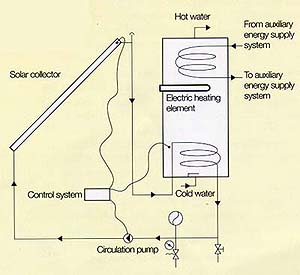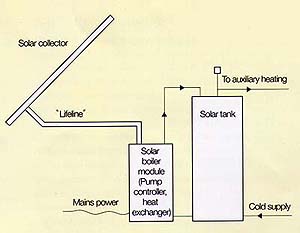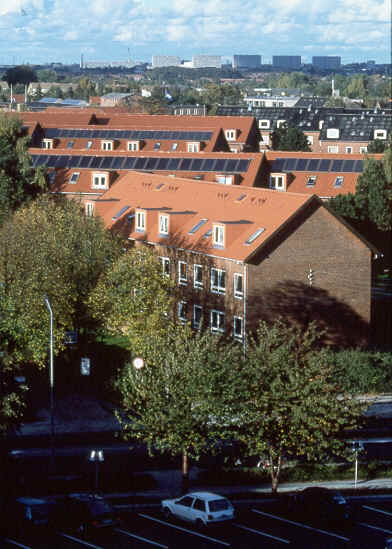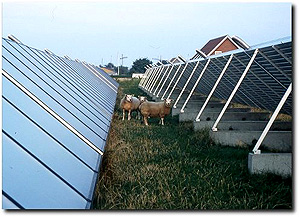 How does a solar water heater work?
How does a solar water heater work?
Solar water heating systems consist of a solar collector and a storage tank connected by two pipes. In the solar collector, the sun's energy is converted to heat in the liquid in the solar collector's channels. This liquid transports the heat through a pipe to the storage tank, where the heat is transferred to the water in the heat exchanger.
The solar heating storage tank substitutes for the normal hot water tank. Solar heating is normally supplemented by an existing water heating system with conventional fuels. (e.g. gas, electricity).
Types of active solar water heaters
There are several common types of solar water heating systems in Northern Europe, North America and Japan, although local conditions and traditions influence the market and introduce local variants.
Typical European single family domestic solar hot water system
|
|
-
Hot water tank situated near the boiler.
-
Collector area 3-6 m².
-
Storage tank volume 100-300 litres, to match daily hot water consumption.
-
Pressurized collector loop, freeze-protected with glycol in the water.

|

|
Typical North American single family domestic solar hot water system
-
Solar water heater with preheat tank.
-
External heat exchanger loop/flexible collector area 5-6 m² tubing.
-
Use of inexpensive standard North American tanks.
-
Auxiliary heating often takes place in a second tank.
|
 |
Variants of this system are
-
Auxiliary heating using a flow-through water-heater or an existing tank (preheating system), instead of a spiral in the top of the tank.
-
A mantle around the tank (low-flow systems) used as the heat exchanger in the collector loop.
-
Drain-back systems, which drain the collectors for freeze-protection.
-
Natural gas/oil-fired boiler integrated in the same cabinet as the solar tank.
-
Extra heat exchanger in the collector loop for space heating.
-
Components of the collector loop integrated with the tank and placed in a single cabinet.
-
Systems with integrated collector and storage (ICS).
New trends for single-family systems are likely to be the increased use of drain-back and low-flow systems, as well as increasing numbers of solar systems integrated with boilers.
Large solar water heating systems
-
Applicable to apartment buildings or industrial premises needing hot process water.
-
Typical collector areas between 30-200 m².
-
Systems are site specific, but generally constructed following principles outlined above.
-
Solar collector often constructed on-site and often roof-integrated.

Large solar collectors for district heating
-
Collectors supply energy to the return pipes from the district heating system.
-
Typically large collector panels (e.g. 12 m²) with high efficiency.
-
Panels often mounted in rows on the ground.
-
May be combined with seasonal storage for typical collector areas of more than 1,000 m².
-
Without seasonal storage, typical collector areas are between 100 m² and 1,000 m².

Large solar heating plant at Marstal District Heating Plant, Denmark.
For more information, you can inquire about the "Canadian Solar Water Heaters Buyer's Guide" (available in January 2000).